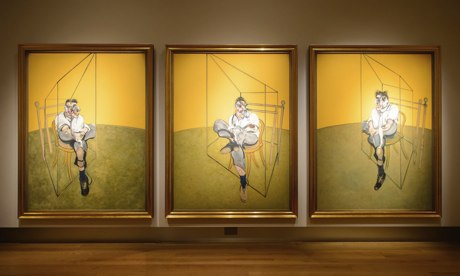Francis Bacon's painting of Lucian Freud is a portrait of two geniuses
The 1969 work is worth every cent of the record-breaking $142m it fetched at auction in New York

Three Studies of Lucian Freud by Francis Bacon on display at Christie's. Photograph: Dominic Lipinski/PA
It was a big night for British art. Once, the painters of these rainy islands were regarded as dreary throwbacks while all the glamour and fame went to modern Europeans and Americans, from Edvard Munch to Andy Warhol.
But on Tuesday evening at Christie's in New York, a triple portrait by Francis Bacon of his friend and peer Lucian Freud sold for $142m (£89m), stomping all over the record auction price of $119m (£74m) paid last year for Munch's Scream.
There can be no doubt the night belonged to Freud as well as Bacon. When he sat for Three Studies of Lucian Freud in 1969, this painter of harshly real faces and bodies in sparse London rooms was ever so slightly in Bacon's shadow. Now they orbit one another as the two great British artists of the 20th century, and probably will always be grouped in art history as blunt individualists who defied the supposed inevitable progress of the readymade to paint like modern reincarnations of Velázquez.
The art market is notoriously fickle. This record will be broken, just as Munch's has been. Auctioneers themselves admit that prices are influenced by such bizarre factors as the use of certain colours – this painting is heavy on the Van Gogh yellow. But sometimes, this less-than-rational market gets it right. Bacon is the real thing, and so is Freud. This is a portrait of two geniuses.
Bacon does not paint like a worthy avant garde follower of Matisse orCezanne. He paints as if he were trained in an Old Master workshop 400 years ago then somehow torn through time into the modern age. Driven mad by the temptations and terrors of the 20th century, his brush creates horrific wounds and knotted masses of flesh with a disturbingly gorgeous painterly texture. It's easy to see why someone would pay tens of millions to have these inside-out Titians on the wall. Bacon's paintings are perversely luxurious. They drip with opulent colour and a velvet magnificence. The pain and brutality that punches through them heightens their strange beauty.
In his triple portrait of Freud he uses the archaic format of the gothic triptych to give the image a three-eyed variety and terrible authority. In the middle ages, many-panelled paintings were hinged so they could fold in and out to tell a religious story. Bacon, who was proud of his Irish origins although he spent his entire career in London, was fascinated by the Christian nature of the triptych. It gave him something to desecrate. From his 1940s masterpiece Three Studies for Figures at the Base of a Crucifixion to Triptych – August 1972, in which he broods on the suicide of his lover George Dyer, a violent vision of a godless universe poisons Bacon's triptychs.
Lucian Freud sits in Bacon's despairing, yet monstrously vital universe, his face taken apart and remade by Bacon's brush. He poses in a white shirt, moving about, full of energy. For both of them art is an act of cruel love. You take someone apart on the canvas to know them from the inside.
Bacon is worth every cent. As he used to say when he was buying the drinks, "Champagne for my real friends – real pain for my sham friends!"
